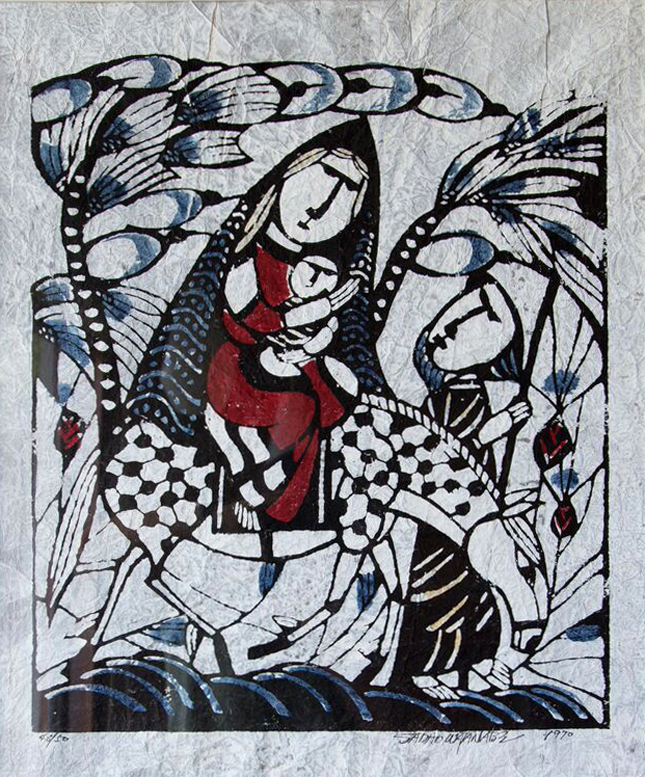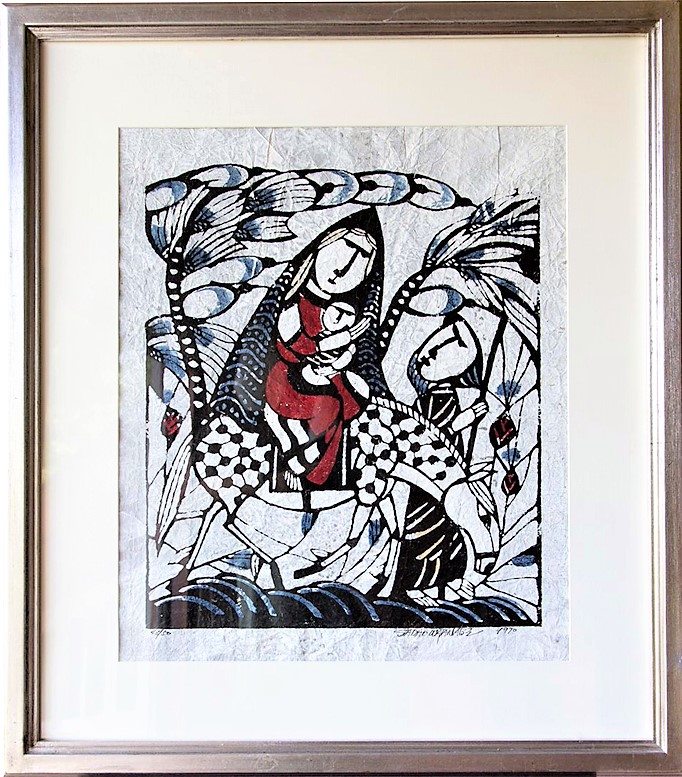![]()
Sadao Watanabe. 1913-1998.


The Flight Into Egypt. 1969. Color dye stencil (Kappazuri). 20 5/8 x 17 5/8 (sheet 27 x 24). Edition 50, #35. Printed on crumpled, hand-made paper on the full sheet with deckle edges. Signed and numbered in ink.Housed in a 35 1/2 x 30 3/4-inch sliver-leaf frame. $2,500.
![]()
Sadao Watanabe, born in Tokyo in 1913, used the medium called kappazuri ("stencil printing"), a technique related to 'katazome' ("stencil dyeing"). 'Katazome' is said to have originated in Okinawa (the method there was called 'bingata'). The paper most widely used in Japan for stencil printing is called 'shibugami', made from several layers of 'kozo' paper laminated with persimmon tannin. The sheets are dried and smoke-cured to strengthen them and make them flexible and waterproof. Once the artist makes a drawing, it is fixed to the 'shibugami' with a thin adhesive. The basic pattern is then carved into a "key impression" stencil (the equivalent to the keyblock in woodblock printing) called the 'omogata'. If colors will also be used for the final design, separate stencils are sometimes cut for each color. If the stencil pattern has thin lines they can be reinforced with silk gauze, which still allow for uniform printing of colors. The first stage of the printing process involves the application and drying of a dye-resist paste to cover all the portions of the design to be left unprinted by the design. The patterns and colors can then be brushed over the stencil while affecting only those areas without resist paste. Typically the first colors printed are the lighter areas so that darker colors can be overprinted. After all the colors are printed and dried, the key impression stencil is finally used to print the key design over all the previous colors. The dye resist paste is then washed off (called 'mizumoto', "to wash by water") and the paper is dried on a wood board. Watanabe typically printed on a colored ground, so he would first apply a color to the paper.
Watanabe, who was baptized a Christian in 1930, based his designs exclusively on Biblical subjects, though his Christian stories and figures are interpreted through a filter of traditional Japanese techniques and even some older Buddhist figure prints. The folk-art movement in Japan began in the 1930s as an attempt to keep alive various traditional arts, among them stencil printing. Watanabe was an early member of a small but important group of artists who dedicated themselves to learning and preserving these arts. Watanabe's emotioonally moving Biblical prints are have been popular throughout the world, and have been hung in the Vatican, the White House, in museums and in private collections.
In 1947 he won the first prize from the JAPAN FOLK ART MUSEUM; and the KOKUGOKAI PRIZE in 1948. A one-man show was held at the Portland Art Museum in l962 and his works were exhibited in the Modern Print Show at the l972 Winter Olympics, Sapporo, Japan. Taught printmaking in Oregon and Minnesota and in 1976 visited America again at the invitation of the Lutheran Church. He had a one-man show at the Grace Cathedral, San Francisco in l977. In 1982, received an honorary Doctor of Fine Arts degree from Linfield College, Oregon. His works are in numerous collections including the New York Museum of Modern Art, Art Institute of Chicago, Honolulu Academy of Arts and the Vatican Museum of Modern Religious Art.
![]()
![]()
To order, to report broken links or to be placed on the email list, please contact Jane Allinson (jane@allinsongallery.com), call (001) 860 429 2322 or fax (001) 860 429 2825. Business hours are 9:A.M. to 5 P.M. Eastern Standard Time.
Please click here to review the
USE AND ACCEPTANCE AND PRIVACY POLICIES FOR THE ALLINSON GALLERY, INC. WEBSITE
Thank you for visiting this website.